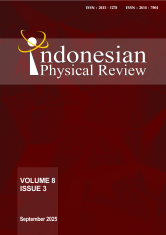ENHANCED THERMAL PERFORMANCE OF POLYETHYLENE GLYCOL-BASED PHASE CHANGE MATERIALS USING ZnO
DOI:
10.29303/ipr.v8i3.485Downloads
Abstract
Polyethylene Glycol (PEG), an organic Phase Change Material (PCM) known for its high latent heat capacity and biocompatibility, suffers from poor thermal conductivity. This research explored the addition of ZnO (at 8 and 12 wt.%) as an enhancer and SDBS as a surfactant, utilizing a two-step homogenization process at 80°C for 4 h. X-ray Diffraction (XRD) analysis confirmed that no chemical interactions or new phases occurred. Differential Scanning Calorimetry (DSC) findings revealed an enhancement in PEG's latent heat of PEG from 214 J/g to 238.3 J/g (with 8 wt.% ZnO) and 257.7 J/g (with 12 wt.% ZnO). The thermal conductivity improved by 28.2% and 30.3%, respectively, while Thermogravimetric Analysis (TGA) demonstrated increased thermal stability. The addition of ZnO can improve the conductivity and thermal stability, while the role of SDBS is significant in increasing the latent heat, making this composite a potential candidate for Thermal Energy Storage system (TES) applications.Keywords:
PEG Phase Change Materials Thermal Energy Storage ZnOReferences
A. Prasad, R. Kumar, S. Sundaramurthy, A. Suresh, R. Ayub, and M. A. Khan, “A review on assessing innovative materials and technologies for carbon dioxide conversion to valuables,†Carbon Capture Sci. Technol., vol. 13, no. 4, 2024.
Z. Y. Xu, R. Z. Wang, and C. Yang, “Perspectives for low-temperature waste heat recovery,†Energy, vol. 176, no. 13, pp. 1037–1043, 2019.
H. Jouhara, N. Khordehgah, S. Almahmoud, B. Delpech, A. Chauhan, and S. A. Tassou, “Waste heat recovery technologies and applications,†Therm. Sci. Eng. Prog., vol. 6, no. 2, pp. 268–289, 2018.
M. T. White and A. I. Sayma, “A new method to identify the optimal temperature of latent-heat thermal-energy storage systems for power generation from waste heat,†Int. J. Heat Mass Transf., vol. 149, no. 4, 2020.
Y. Huang, Z. Deng, Y. Chen, and C. Zhang, “Performance investigation of a biomimetic latent heat thermal energy storage device for waste heat recovery in data centers,†Appl. Energy, vol. 335, no. 8, 2023.
D. Li, J. Wang, Y. Ding, H. Yao, and Y. Huang, “Dynamic thermal management for industrial waste heat recovery based on phase change material thermal storage,†Appl. Energy, vol. 236, no. 3, pp. 1168–1182, 2019.
A. K. Sinha, P. K. Gupta, and R. K. Rathore, “Advancements in Enhancing Heat Transfer of Latent Heat Storage Systems: a Review on Phase Change Materials,†Energy Environ. Effic. Resour. Glob., vol. 10, no. 1, pp. 118–143, 2024.
K. Zhang, C. Hu, H. Huang, B. Li, C. Huang, and S. Wang, “Achieving efficient energy utilization by PCM in the food supply chain: Encapsulation technologies, current applications, and future prospects,†J. Energy Storage, vol. 79, no. 5, 2024.
R. Gulfam, P. Zhang, and Z. Meng, “Advanced thermal systems driven by paraffin-based phase change materials – A review,†Appl. Energy J., vol. 238, no. 5, pp. 582–611, 2019.
Q. Al-Yasiri and M. Szabó, “Paraffin As a Phase Change Material to Improve Building Performance: An Overview of Applications and Thermal Conductivity Enhancement Techniques,†Renew. Energy Environ. Sustain., vol. 6, no. 1, p. 38, 2021.
O. Okogeri and V. N. Stathopoulos, “What about greener phase change materials? A review on biobased phase change materials for thermal energy storage applications,†Int. J. Thermofluids, vol. 10, no. 2, 2021.
B. Liang, X. Lu, R. Li, W. Tu, Z. Yang, and T. Yuan, “Solvent-free preparation of bio-based polyethylene glycol/wood flour composites as novel shape-stabilized phase change materials for solar thermal energy storage,†Sol. Energy Mater. Sol. Cells, vol. 200, no. 12, 2019.
Y. Kou et al., “Thermal analysis and heat capacity study of polyethylene glycol (PEG) phase change materials for thermal energy storage applications,†J. Chem. Thermodyn., vol. 128, no. 1, pp. 259–274, 2019.
A. Kim, N. A. Wert, E. B. Gowd, and R. Patel, “Recent Progress in PEG-Based Composite Phase Change Materials,†Polym. Rev., vol. 63, no. 4, pp. 1078–1129, 2023.
P. Cheng et al., “Different dimensional nanoadditives for thermal conductivity enhancement of phase change materials: Fundamentals and applications,†Nano Energy, vol. 85, no. 8, 2021.
A. K. Ansu, R. K. Sharma, F. Y. Hagos, D. Tripathi, and V. V. Tyagi, “Improved thermal energy storage behavior of polyethylene glycol-based NEOPCM containing aluminum oxide nanoparticles for solar thermal applications,†J. Therm. Anal. Calorim., vol. 143, no. 3, pp. 1881–1892, 2021.
M. A. Sheik, M. K. Aravindan, N. Beemkumar, P. K. Chaurasiya, and J. A. Dhanraj, “Enhancement of Heat Transfer in PEG 1000 Using Nano-Phase Change Material for Thermal Energy Storage,†Arab. J. Sci. Eng., vol. 47, no. 12, pp. 15899–15913, 2022.
M. Ouikhalfan, G. Hekimoǧlu, A. Sari, O. Gencel, and V. V. Tyagi, “Metal Oxide Nanoparticle Dispersed-Polyethylene Glycol: Thermal Conductivity and Thermal Energy Storage Properties,†Energy and Fuels, vol. 36, no. 5, pp. 2821–2832, 2022.
P. P. Dutta, V. Saxena, A. Kumar, and S. K. Sahu, “Investigation of finned heat sinks with PEG-6000/EG and PEG-6000/MWCNT composite phase change material for thermal management application,†J. Energy Storage, vol. 70, no. 14, 2023.
L. He, H. Wang, H. Zhu, Y. Gu, X. Li, and X. Mao, “Thermal properties of PEG/graphene nanoplatelets (GNPs) composite phase change materials with enhanced thermal conductivity and photo-thermal performance,†Appl. Sci., vol. 8, no. 12, 2018.
Q. Tan, H. Liu, Y. Shi, M. Zhang, B. Yu, and Y. Zhang, “Lauric acid/stearic acid/nano-particles composite phase change materials for energy storage in buildings,†J. Energy Storage, vol. 76, no. 2, 2024.
N. H. M. Zaimi, A. Nawabjan, S. F. A. Rahman, S. M. Hussin, and S. N. N. A. Hamidon, “Evaluating the Role of Sodium Dodecylbenzene Sulfonate as Surfactant Towards Enhancing Thermophysical Properties of Paraffin/Graphene Nanoplatelet Phase Change Material: Synthesis and Characterization in PV Cooling Perspective,†Int. J. Thermophys., vol. 43, no. 1, pp. 1–25, 2022.
N. kumar Srinivasan and C. Ponnusamy, “Influence of various surfactants on the stability and solidification characteristics of DI water-based CuO NFPCM for cool thermal energy storage system,†J. Energy Storage, vol. 86, no. 12, 2024.
V. Arasu, D. Kumar, and I. Khan, “Experimental investigation of thermal conductivity and stability of TiO2-Ag/water nanocompositefluid with SDBS and SDS surfactants,†Thermochim. Acta, vol. 678, no. 8, 2019, doi: 10.1016/j.tca.2019.178308.
D. Cabaleiro et al., “Review on phase change material emulsions for advanced thermal management: Design, characterization and thermal performance,†Renew. Sustain. Energy Rev., vol. 159, no. 7, 2022.
K. Mubeen et al., “Band structure tuning of ZnO/CuO composites for enhanced photocatalytic activity,†J. Saudi Chem. Soc., vol. 27, no. 3, 2023.
N. Jahan Tamanna, M. Sahadat Hossain, N. Mohammed Bahadur, and S. Ahmed, “Green synthesis of Ag2O & facile synthesis of ZnO and characterization using FTIR, bandgap energy & XRD (Scherrer equation, Williamson-Hall, size-train plot, Monshi- Scherrer model),†Results Chem., vol. 7, no. 1, 2024.
A. D. Oktavia and L. Rohmawati, “Fabrication of Fe3O4/ZnO Nanocomposite by Ultrasonication Wave Method and Its Application for Antibacterial,†Indones. Phys. Rev., vol. 5, no. 3, pp. 177–187, 2022.
N. Praveenkumar, K. Lingadurai, T. Ramkumar, and R. Bharathiraja, “Characterization and thermophysical property evaluation of ceramic and metal oxide-based hybrid nanoparticles enhanced paraffin PCM,†J. Therm. Anal. Calorim., vol. 150, no. 1, 2025.
A. Kaleni, K. Lebelo, M. J. Mochane, T. C. Mokhena, and M. T. Motloung, “Recent progress on the morphology and thermal cycle of phase change materials (PCMs)/conductive filler composites: a mini review,†J. Polym. Eng., vol. 42, no. 9, pp. 827–845, 2022.
Q. Wang, D. Zhou, Y. Chen, P. Eames, and Z. Wu, “Characterization and effects of thermal cycling on the properties of paraffin/expanded graphite composites,†Renew. Energy, vol. 147, no. 3, pp. 1131–1138, 2020.
A. C. B. Jesus et al., “Synthesis and magnetic interaction on concentrated Fe3O4 nanoparticles obtained by the co-precipitation and hydrothermal chemical methods,†Ceram. Int., vol. 46, no. 8, pp. 11149–11153, 2020.
B. Himabindu, N. S. M. P. Latha Devi, and B. Rajini Kanth, “Microstructural parameters from X-ray peak profile analysis by Williamson-Hall models; A review,†Mater. Today Proc., vol. 47, no. 14, pp. 4891–4896, 2021.
A. S. Fleischer, Thermal energy storage using phase change materials: Fundamentals and applications. Springer International Publishing Switzerland, 2015.
S. Ranjbar, H. Masoumi, R. Haghighi Khoshkhoo, and M. Mirfendereski, “Experimental investigation of stability and thermal conductivity of phase change materials containing pristine and functionalized multi-walled carbon nanotubes,†J. Therm. Anal. Calorim., vol. 140, no. 5, pp. 2505–2518, 2020.
N. K. Noran, A. K. Pandey, J. Selvaraj, D. Buddhi, and V. V Tyagi, “Surfactant role in nano-enhanced phase change materials,†6th Int. Conf. Clean Energy Technol., vol. 1281, no. 1, p. 012043, 2023.
S. Sami and N. Etesami, “Improving thermal characteristics and stability of phase change material containing TiO2 nanoparticles after thermal cycles for energy storage,†Appl. Therm. Eng., vol. 124, no. 15, pp. 346–352, 2017.
H. M. Ali et al., “Advances in thermal energy storage: Fundamentals and applications,†Prog. Energy Combust. Sci., vol. 100, no. 1, 2024.
X. Cheng et al., “Stable and reliable PEG/TiO2 phase change composite with enhanced thermal conductivity based on a facile sol-gel method without deionized water,†J. Energy Storage, vol. 89, no. 100, 2024.
M. Pandya, A. Kumar Ansu, and R. Kumar Sharma, “Copper based nano Materials-Enhanced phase change materials with great potential for improved thermal energy storage properties,†Mater. Today Proc., vol. 63, no. 15, pp. 786–789, 2022.
C. Wang, Z. Cai, K. Chen, J. Huang, and T. Wang, “Preparation and thermal properties of shapeâ€stabilized polyethylene glycol/mesoporous silica composite phase change materials for thermal energy storage,†Energy Storage, vol. 1, no. 2, pp. 1–10, 2019.
B. K. Choure, T. Alam, and R. Kumar, “A review on heat transfer enhancement techniques for PCM based thermal energy storage system,†J. Energy Storage, vol. 72, no. 20, 2023.
J. Tan and Y. Zhang, “Thermal Conductive Polymer Composites: Recent Progress and Applications,†Molecules, vol. 29, no. 15, 2024.
S. Tan and X. Zhang, “Progress of research on phase change energy storage materials in their thermal conductivity,†J. Energy Storage, vol. 61, no. 5, 2023.
S. H. Kim, S. R. Choi, and D. Kim, “Thermal conductivity of metal-oxide nanofluids: Particle size dependence and effect of laser irradiation,†J. Heat Transfer, vol. 129, no. 3, pp. 298–307, 2007.
M. A. Fikri, S. K. Suraparaju, M. Samykano, A. K. Pandey, and R. K. Rajamony, “Enhanced Thermal Properties of Phase Change Materials through Surfactant-Functionalized Graphene Nanoplatelets for Sustainable Energy Storage,†Energies, vol. 16, no. 22, 2023.
L. Qiu, K. Yan, Y. Feng, and X. Liu, “Nano additives-enhanced PEG /AlN composites with high cycle stability to improve thermal and heat storage properties,†Energy, vol. 278, no. 18, 2023.
A. P. Tetuko et al., “Encapsulation of paraffin-magnetite, paraffin, and polyethylene glycol in concretes as thermal energy storage,†J. Energy Storage, vol. 68, no. 12, 2023.
B. Tang, C. Wu, M. Qiu, X. Zhang, and S. Zhang, “PEG/SiO2-Al2O3 hybrid form-stable phase change materials with enhanced thermal conductivity,†Mater. Chem. Phys., vol. 144, no. 1–2, pp. 162–167, 2014.
H. Zhang, Q. Sun, Y. Yuan, and X. Cao, “Porosity reduction of polyethylene glycol phase change materials by using nanoscale thermal-energy-conducting medium during crystallization process,†J. Appl. Polym. Sci., vol. 134, no. 43, pp. 1–9, 2017.
License

This work is licensed under a Creative Commons Attribution-NonCommercial-ShareAlike 4.0 International License.
Authors who publish with Indonesian Physical Review Journal, agree to the following terms:
- Authors retain copyright and grant the journal right of first publication with the work simultaneously licensed under a Creative Commons Attribution-ShareAlike 4.0 International Licence (CC BY SA-4.0). This license allows authors to use all articles, data sets, graphics, and appendices in data mining applications, search engines, web sites, blogs, and other platforms by providing an appropriate reference. The journal allows the author(s) to hold the copyright without restrictions and will retain publishing rights without restrictions.
- Authors are able to enter into separate, additional contractual arrangements for the non-exclusive distribution of the journal's published version of the work (e.g., post it to an institutional repository or publish it in a book), with an acknowledgment of its initial publication in Indonesian Physical Review Journal.
- Authors are permitted and encouraged to post their work online (e.g., in institutional repositories or on their website) prior to and during the submission process, as it can lead to productive exchanges, as well as earlier and greater citation of published work (See The Effect of Open Access).





